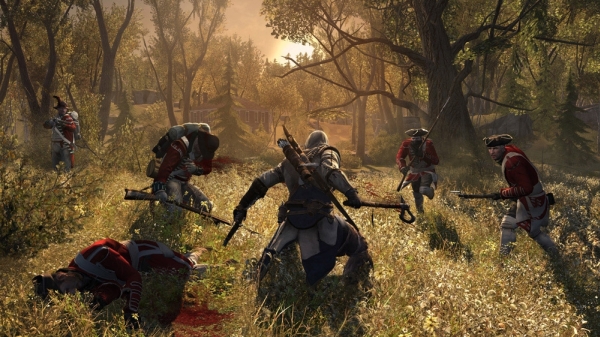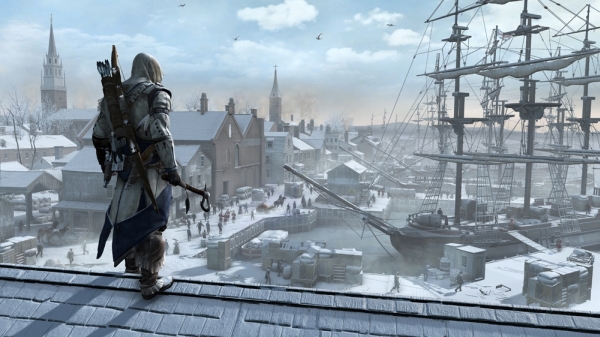
I’m going to open this review with an honest disclaimer, I’ve never liked the Assassin’s Creed franchise. While the concept of an open-world assassination game sounds just fine, quite exciting even, the actual execution felt lacklustre with cumbersome controls and free roam diluted down to near nonexistent levels. “Kill your targets any way you want,” the adverts said, but what they failed to mention was that unless you adhered to Ubisoft-approved killing methods within Ubisoft-sanctioned locations your open-world experience would suddenly feel like a confined cardboard box as the game punished you for not playing it right. I tried the second game for all of an afternoon before the masquerade fell away and left me feeling cold, cheated and unloved. All subsequent games failed to rekindle our relationship; I just couldn’t get interested, but for some reason (clue: my interest in Colonial America) I somehow found myself falling for the hype and giving this franchise another chance with Assassin’s Creed III.
Platforms: PC, PS3 (Version Played), Xbox 360
Publisher: Ubisoft
Developer: Ubisoft Montreal
Genre: Stab-Them-in-the-Back ’em Up
Release Date: October 30, 2012
ESRB Rating: Mature
Initially I was a tad fearful of not being able to follow the plot having skipped the most recent games, but after a brief introduction sequence with Desmond and company, I was up-to-date and soon jumping into the polished leather shoes of one Mr. Haytham Kenway in a British opera house. Hang on… what about that fiery Native American fellow I was promised in the adverts? Had Ubisoft fooled me once again? Well it turns out that the Kenway portion makes up a massive part of the game’s prologue, charting his lengthy voyage and immediate arrival to the New World, then following him as he sets about assembling a gang of rogues to locate a cave harbouring an artefact belonging to the First Civilization. That’s all I’m going to spoil about the plot by the way, not like that kid on Amazon who spoiled the ending to BioShock in his review; this is one tale you will need to experience for yourself to fully appreciate it.
Kenway’s arrival in Boston is nothing short of epic with a myriad of soldiers, civilians and animals rushing about the hectic, grime-soaked streets. This is quite a leap from the partially populated alleyways of Italy whose supposedly busy marketplaces were more akin to quiet afternoons. Here the amount of characters on screen is impressive and you really appreciate the change to a location teeming with life; it suits the hustle and bustle of the time period perfectly. The following three to four hours then act (and at times fail) as an extended tutorial, showing off new tricks and introducing changes, one of which are the optional objectives that come with each mission. While the early ones ask nothing more than to kill a certain amount of enemies, attack targets at long range or perhaps use a particular technique, don’t consider them mundane. Later objectives can be brutally challenging, forcing you to adopt to new play styles or forgo idyllic solutions just to meet the criteria.
In time you take on the role of Connor (aka: the Native American fellow) and it’s here where the game really comes alive. I remember reading concerns about an outdoor setting without any buildings to climb, but the ease and fluidity of navigating through the treetops actually makes you regret having to visit urban locations such as Boston and New York. Don’t get me wrong, the climbing mechanics are competent, but after racing through the glowing branches of an autumn forest, going back to dull (though detailed) cityscapes feels rather monotone and downbeat in comparison. I wonder if the intention behind this was to evoke similar feelings to what the Native Americans must have felt when their land was taken over.
On the topic of land the vistas in this game are absolutely stunning. Both in cities and out on the frontier, with changing seasons not only bringing visual distinction but also opening up new paths and approaches as trees shed their leaves and snow falls. As a Native American protagonist, hunting plays a big part in the game and although never essential (unless you wish to make crafts – see below), there is a fair amount of depth on offer as you’re able to set traps, lay bait, track footprints and leap from the tall branches of a tree to spear a raccoon with your hidden blades. Skins, meats, and even teeth from fallen prey can then be crafted into more elegant items which in turn are sold via your homestead for a supplemental income. As you progress through the game additional residents will seek to move in such as woodcutters, inventors, or the occasional assassin, each who have something to offer and something to ask.

This leads to a plethora of side missions and items to collect, a tad too much at times, but again, making them optional lessens what could have been a tiresome experience. Some missions, like the liberation ones in which the locals need help fighting off the British forces, can be exciting to the point of besting main quests; others like the additional assassinations, often feel tacked on for no good reason other than to lengthen the game. At least one of the game’s biggest selling points, the much fabled naval battles, are both substantive and thrilling, almost to the point of being a whole separate game in itself. Pirate’s Creed anyone?
The problem though is that beneath the new surface Assassin’s Creed III soon falls into familiar line with the rest of the franchise, forgoing originality and true creativeness for more of the same albeit re-skinned. A vast majority of the main missions feel like nothing more than “go here – watch a video – go there – watch another video – do something quickly – end” exercises that once again left me feeling somewhat cheated out of what should have been a fantastic experience. Many of the big finales to missions feel like they’re running on auto-pilot, almost as if Ubisoft was worried that uninitiated gamers (such as myself) would mess things up and ruin what should be a cinematic scene. As a result freedom is limited and many climatic kills or dramatic highs play out through cutscenes rather than allowing direct player control. You’re left turning back to open world events to get your action fix, like some poor old failure kicked out of the main show. It almost makes you feel dirty.
That said, when the action does happen it can feel wonderfully brutal. While stealth is present and at times encouraged, it’s clearly taken a back seat this time around with the addition of fast-flowing combat that sees you countering and executing opponents with ease. Now leaping/falling badly into a group of soldiers isn’t the immediate death sentences thanks to the ability to duel wield knives, swords, tomahawks, arrows and muskets which will no doubt be expanded through a mountain of further downloadable content. I’d even go as far to say that this game is perhaps more Batman: Arkham City with a bigger budget than it is an Assassin’s Creed game (certainly not an insult) as the sun sets over a thick forest canopy accompanied by the sounds of drums, trumpets, musket fire and screams. This is your Last of the Mohicans fantasy right here in digital form if you are willing to set up the scenarios for yourself.
However, as expected with a game of this grand scale, there are some shortcomings that bring down the curtains on an otherwise amusing premise. To say the game has bugs is an understatement; character models will often get stuck in the scenery (ever see a horse and cart half-submerged into a wall?), map markers have a tendency to just disappear and objectives can fail for no other reason than pot luck. A patch will be released to fix these in time but for those stuck offline, these problems are something to be considered. Other niggles, though not as severe, include the use of bold white text on bright white backgrounds making letters close to unreadable, context-specific button presses that require pinpoint accuracy or characters suddenly freezing during scripted animations. Hopefully these too will be patched up soon.

My biggest problem revolves around accessibility in early parts of the game where new players are first getting their bearings, particularly when I was requested to do something without being told how. Of course I don’t expect to be led by the hand in this day and age (I’m looking at you Nintendo) but some decent instruction on how to perform some of the more unusual things, like corner assassinations or even weapon switching for the first time would have helped, especially as the game lacks a substantial physical instruction manual. I feel that guidance was perhaps overlooked by developers who wrongly assumed that players would already be familiar with workings of previous games, causing an obstacle for new players like myself.
Another problem was that even if I did know how to perform a specific function (thanks Internet), the return of weak and cumbersome controls from the second game meant it was still troublesome to achieve. The lock-picking segments in particular are what can best be described as a convoluted mess, requiring players to rotate thumb sticks and mash buttons in a desperate hope that the game registers your input before suddenly cancelling your actions for no apparent reason. The windows of opportunity for button presses is incredibly narrow; a split second out of time and leaps will turn into falls or a musket reload will just stop mi- sequence like a sulking child refusing to leave the toy store. Could this be the reason for the excessive use of auto-pilot?
One section in particular had me close to giving up with the series a second time; one where I had to pursue an enemy on horseback while simultaneously shooting targets on the battlefield. An unhelpfully brief message told me to press triangle to shoot but doing so gave zero response and the mission, because I had missed the split-second timing, came to an abrupt end. For my second attempt, I tried holding the triangle button down (nothing again) and for the third I tried pressing it in rapid succession, still to no avail. After a rather childish ‘controller through the air’ moment I came back for now a fourth attempt and this time, to my complete bemusement, pressing triangle to shoot the first target worked but failed to respond on the second. To cut an otherwise long rant short, I had to restart that sequence over ten times, not because it was difficult or challenging but because the controls were just so frustratingly unresponsive.
Deep down, I’m hoping this is just me, and will change as I become more familiar with the game. Despite the flaws, lack of coherent structure and bad design decisions, I believe there to be a good concept hidden inside. Whether previous Assassin’s Creed games have damaged the series’ reputation remains to be seen; the franchise of late has been flogged more than the proverbial dead horse and I suspect that the lifelong fans may find little new here. For newcomers and previous haters like myself, the unique setting and polished visuals could be enough pull to drum up interest and tempt further exploration into the world of assassins, templars and melodramatic plotlines. Spearing chipmunks has certainly never been this fun.

Review Disclosure: A retail copy of Assassins Creed III was purchased by Warp Zoned for the purposes of this review.







